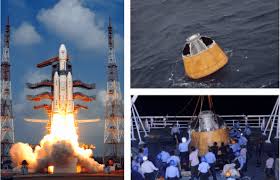Human Rated Launch Vehicle (HLVM3):

Union Minister confirmed in Parliament that India has completed the development and ground testing of the Human Rated Launch Vehicle (HLVM3) for the Gaganyaan mission, marking a key milestone ahead of India’s first human spaceflight.
- The long-term vision includes the Bharatiya Antariksha Station by 2035 and Indian Moon Landing by 2040.
- HLVM3 is India’s first human-rated launch vehicle, adapted from the proven LVM3 (GSLV Mk III) platform, designed to safely carry astronauts (Gaganyatris) into Low Earth Orbit under the Gaganyaan programme.
- Developed By Indian Space Research Organisation (ISRO)
- Designed under the guidance of the Human Space Flight Centre (HSFC)
- Mission Aim:
- Enable safe launch, orbital insertion, and return of Indian astronauts.
- Form the backbone for future long-term missions like Bharatiya Antariksha Station and Indian lunar landing.
- Build self-reliant capacity in human space exploration and demonstrate advanced space safety systems.
- Key Features of HLVM3:
- Two S200 solid rocket boosters, L110 liquid core stage, and C25 cryogenic stage.
- Capable of lifting ~10 tonnes to Low Earth Orbit.
- Systems upgraded for redundancy, fault-tolerance, and escape options.
- Designed with higher safety margins and enhanced quality assurance protocols.
- Five types of motors already tested.
- Enables safe ejection of crew during ascent in emergencies.
- Operational from liftoff to orbital injection phase.
- Crew Module (CM) tested for re-entry, parachute deployment, thermal resistance. and Service Module (SM) tested for re-entry, parachute deployment, thermal resistance.




